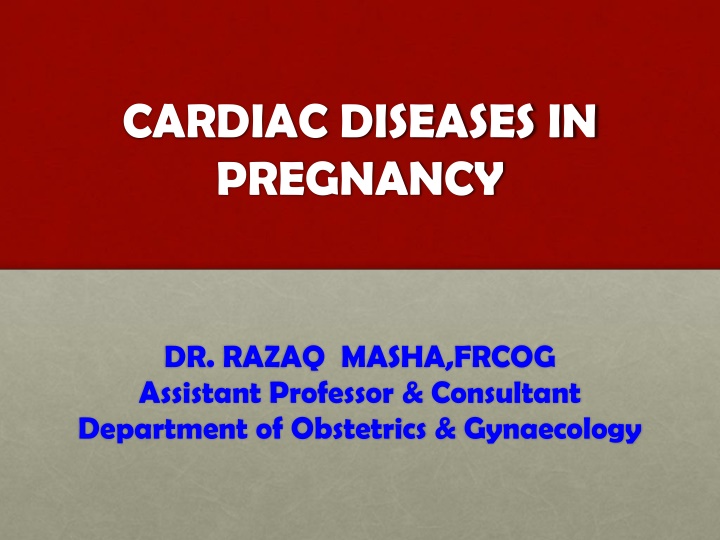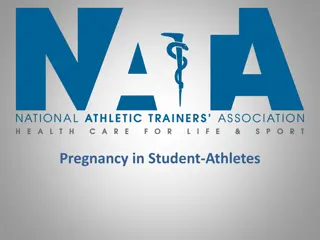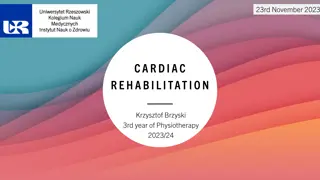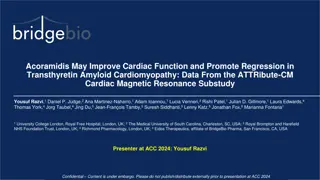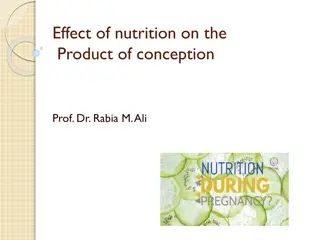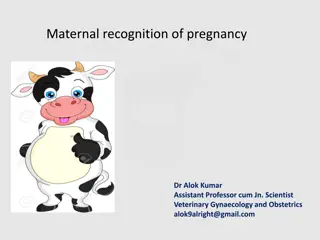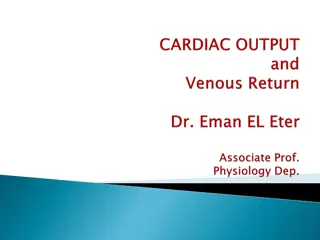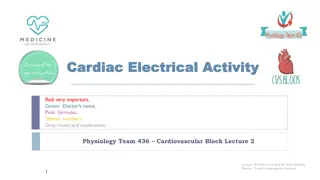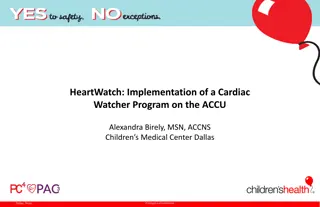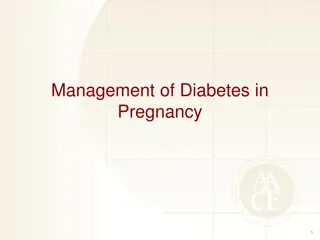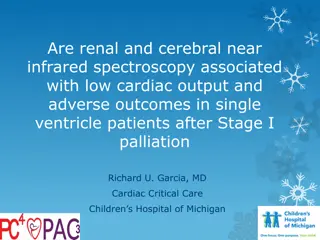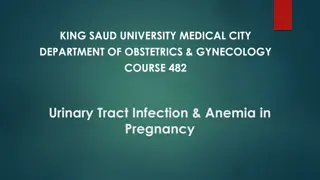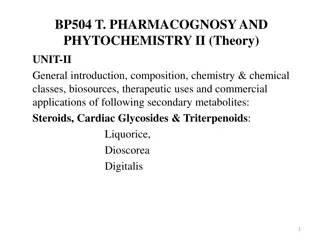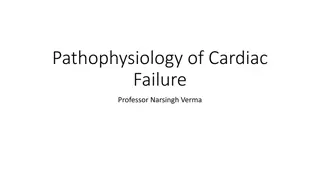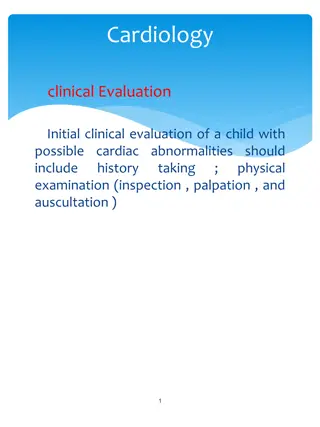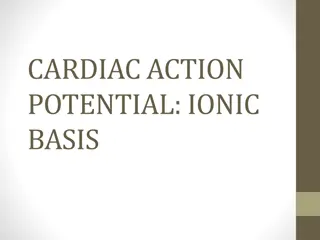Cardiac Diseases in Pregnancy: Implications and Management
Normal pregnancy induces significant physiologic changes in the cardiovascular system, which can impact women with pre-existing cardiac diseases. Understanding the New York Heart Association classification scheme is crucial for assessing symptomatology during pregnancy. Rheumatic Heart Disease, particularly Mitral stenosis, poses specific challenges and requires careful monitoring and management to prevent serious complications. Treatment options may include beta-blockers, digoxin, heparin, and surgical interventions like balloon valvuloplasty. Proper cardiac monitoring during labor and delivery is essential to avoid complications.
Download Presentation

Please find below an Image/Link to download the presentation.
The content on the website is provided AS IS for your information and personal use only. It may not be sold, licensed, or shared on other websites without obtaining consent from the author.If you encounter any issues during the download, it is possible that the publisher has removed the file from their server.
You are allowed to download the files provided on this website for personal or commercial use, subject to the condition that they are used lawfully. All files are the property of their respective owners.
The content on the website is provided AS IS for your information and personal use only. It may not be sold, licensed, or shared on other websites without obtaining consent from the author.
E N D
Presentation Transcript
CARDIAC DISEASES IN PREGNANCY DR. RAZAQ MASHA,FRCOG Assistant Professor & Consultant Department of Obstetrics & Gynaecology
Normal pregnancy results in many physiologic changes that can stress the cardiovascular system By 6-8 weeks of gestation, increase in plasma volume has started and may be up to 45% greater by 30-34 weeks. Red cell volume increases but only by 25% resulting in physiologic anaemia. Cardiac output increases by 30% to 50% during the first half of pregnancy stroke volume and heart rate increase. Cardiac output increases by another 30% during active labour and by 45% during pushing. Systemic vascular resistance decreases during pregnancy (2ndtrimester) and returns to pre-pregnancy levels in the third trimester. During labour each uterine contraction results in an auto transfusion of 300-500 ml of blood At delivery, cardiac output increases as a result of auto transfusion caused by relief of caval compression by the involuting uterus.
Women with cardiovascular disease may tolerate these physiologic changes poorly. The New York Heart Association (NYHA) classification scheme is used for quantifying symptomatology Class I : Patients are asymptomatic in all situations Class II: Patients are symptomatic with greater-than normal exertion Class III: Patients are symptomatic with normal activities Class IV: Patients are symptomatic at rest For most patients, any change in cardiac classification during the pregnancy, even from Class I to II, can be ominous and should prompt a thorough evaluation and aggressive management.
Rheumatic Heart Disease Results from rheumatic fever, caused by Group A, haemolytic streptococcus. Even though the prevalence of rheumatic heart disease rheumatic valvular disorders still account for a substantial proportion of heart disease in reproductive age women. has decreased significantly, a. Mitral stenosis This is the most common form of rheumatic heart disease in women. Even though rheumatic fever may occur at age 6- 15 years, symptoms may not begin until the early 30 s. Initial symptoms include fatigue and dyspnoea exertion at rest, and haemoptysis. dyspnoea
The stenosis impairs left ventricular filling reducing cardiac output. Left atrial volume and pressure increase, pulmonary venous pressure increases and eventually pulmonary hypertension,right ventricular hypertrophy and failure. Other serious complications are atrial fibrillation and pulmonary oedema-which can lead to death. Treatment: Beta blockers for tachycardia Digoxin and heparin if there is atrial fibrillation Some may require surgery balloon valvuloplasty During labour, cardiac monitoring is essential avoiding overloading. Pain must be managed effectively Epidural can be useful if you avoid overload Antibiotic prophylaxis for SBE ampicillin and gentamycin 30 minutes before delivery.
b. Mitral insufficiency This results in regurgitation of blood from the left ventricle3 back into the left atrium, with resulting left atrial enlargement. If pulmonary oedema, embolism, atrial tachycardia and infective endocarditis occur during pregnancy, then such patients can develop complications . Avoid overload, atrial fibrillation, hypertension. Manage pain of labour with epidural. Antibiotic prophylaxis for SBE.
Aortic Insufficiency This causes a chronic increase in left ventricular volume, leading to increased end-diastolic pressure and pulmonary congestion and oedema. Most pregnant women with AI are relatively asymptomatic because of a. Decreased systemic vascular resistance b. Increased heart rate of pregnancy During labour, the changes may lead to decomposition if systemic vascular resistance is increased by pain. Pain relief by epidural. No overload of fluid. Antibiotic prophylaxis for SBE.
Aortic Stenosis This tends to occur in women over 40 years. If it however occurs in the reproductive age, the symptoms include angina, syncope and shortness of breath. Can result in left ventricular failure and infective endocarditis. Maintain adequate fluid volume. Pain relief by narcotics, epidural may cause decreased systemic resistance which is poorly tolerated.
Congenital Heart Disease Women who have undergone surgical correction have normal hemodynamics and tolerate pregnancy well. Women with uncorrected lesions require special management. The most uncontrolled lesions are: Atrial Septal Defects (ASD) Patent Ductus Arteriosus (PDA) Ventricular Septal defect (VSD) Pulmonary Stenosis Coarctation of the aorta Tetralogy of Fallot Both maternal and fetal outcomes depend on the nature of the cardiac lesion. In the presence of cyanosis, there is an increased risk of functional deterioration, congestive heart failure, maternal mortality, IUGR, preterm birth, miscarriage and still-births.
Left to Right Intra Cardiac Shunts These shunts can result from ASDs, VSDs, or PDAs. If there is no pulmonary hypertension and the patient is asymptomatic, pregnancy does not impose significant increased risk. If however, the shunt is substantial resulting in many years of increased pulmonary blood flow, pulmonary hypertension and right heart failure can develop and the shunt reverses. The combination of pulmonary hypertension and right-to-left shunt through any communication between the systemic and pulmonary circulation is know as Eisenmenger syndrome. - Maternal mortality rate of 40% to 60% - Perinatal mortality rate of 28% to 55% -Should be discouraged to get pregnant - Delivery : Excellent pain management - Shorten 2nd stage of labour - Antibiotic prophylaxis for SBE
Peripartum Cardiomyopathy Congestive heart failure characterized by dilatation of the four chambers of the heart. Occurs in the last months of pregnancy or the first 5 months postpartum. Complaints are orthopnea, dyspnea, edema ECG, Chest X-ray, echocardiogram will show cardiomegaly Treat heart failure with digitals, diuretics, or vasodilators, bed rest and anti coagulation. Mortality is high if heart size does not return to normal in 6 months. Advised not to get pregnant because 50% will develop cardiomyopathy in future pregnancies with high mortality rate.
Myocardial Infarction The risk in a reproductive age woman is low (1 in 10,000). Risk factors include arteriosclerosis, thrombosis and vasospastic disease. Maternal mortality is higher in the 3rd trimester. MANAGEMENT: Bed rest to minimize cardiac workload Nitrates, aspirin, beta blockers Calcium channel blocks Epidural anaesthesia in labour and oxygen Avoid another pregnancy for at least one year after M1 if ventricular function has returned to normal.
